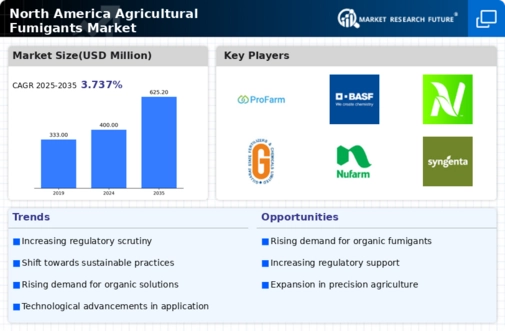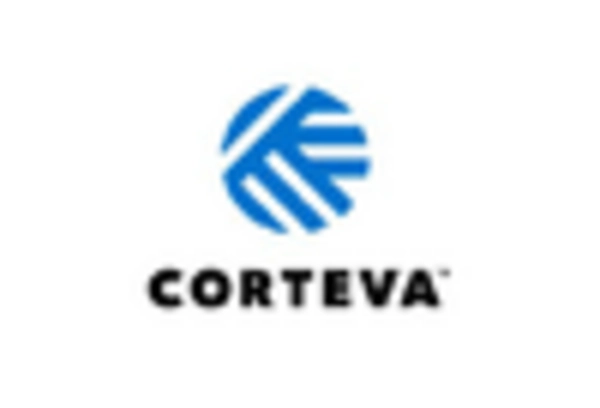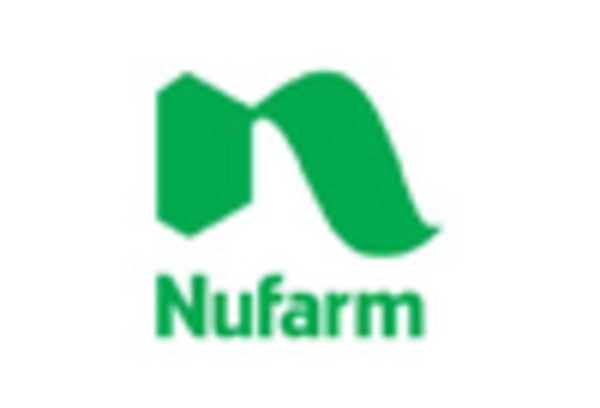Rising Demand for Food Security
The agricultural fumigants market is experiencing a notable surge in demand driven by the increasing need for food security in North America. As the population continues to grow, the pressure on agricultural production intensifies, necessitating effective pest control measures. Fumigants play a crucial role in safeguarding crops from pests and diseases, thereby enhancing yield and quality. According to recent data, the agricultural sector in North America is projected to grow at a CAGR of approximately 4.5% over the next five years, further emphasizing the importance of fumigants in maintaining food supply chains. This rising demand for food security is likely to propel the agricultural fumigants market forward, as farmers seek reliable solutions to protect their crops and ensure sustainable production.
Increased Awareness of Pest Resistance
The agricultural fumigants market is also being shaped by the growing awareness of pest resistance among farmers and agricultural stakeholders. As certain pests develop resistance to conventional pesticides, the need for alternative solutions, such as fumigants, becomes increasingly apparent. This awareness is prompting farmers to adopt integrated pest management strategies that incorporate fumigation as a key component. Research indicates that the use of fumigants can effectively manage resistant pest populations, thereby ensuring crop health and productivity. Consequently, the agricultural fumigants market is likely to expand as more producers recognize the importance of utilizing these solutions to combat pest resistance and maintain sustainable agricultural practices.
Regulatory Support for Pest Control Solutions
The agricultural fumigants market benefits from increasing regulatory support aimed at enhancing pest control solutions. Government agencies in North America are implementing policies that encourage the use of effective fumigants to combat pest infestations. This regulatory framework not only promotes the adoption of advanced fumigation techniques but also ensures that these practices align with environmental safety standards. For instance, the Environmental Protection Agency (EPA) has established guidelines that facilitate the registration and use of certain fumigants, thereby fostering innovation in pest management. As a result, the agricultural fumigants market is likely to witness growth, as farmers and agricultural businesses are incentivized to utilize these solutions to comply with regulations while maximizing crop protection.
Technological Innovations in Fumigation Practices
Technological advancements are significantly influencing the agricultural fumigants market, as innovations in fumigation practices enhance efficiency and effectiveness. The introduction of precision application technologies, such as drones and automated systems, allows for targeted delivery of fumigants, minimizing waste and environmental impact. Furthermore, the development of new formulations and delivery methods is expected to improve the efficacy of existing fumigants. Market data indicates that the adoption of these technologies could lead to a reduction in application costs by up to 20%, making fumigation more accessible to farmers. As these innovations continue to evolve, they are likely to drive growth in the agricultural fumigants market, enabling producers to achieve better pest control outcomes.
Expansion of Export Markets for Agricultural Products
The agricultural fumigants market is poised for growth due to the expansion of export markets for agricultural products. North American farmers are increasingly looking to international markets to sell their produce, which necessitates stringent pest control measures to meet export standards. Fumigants are essential in ensuring that crops are free from pests and diseases, thereby complying with the phytosanitary requirements of importing countries. Recent statistics suggest that agricultural exports from North America are expected to increase by approximately 5% annually over the next few years. This trend is likely to drive demand for fumigants, as producers seek to enhance the quality and safety of their products for global markets.


















Leave a Comment